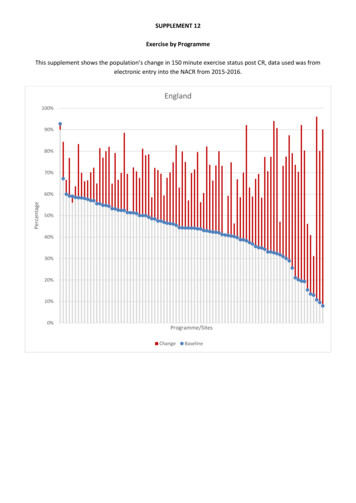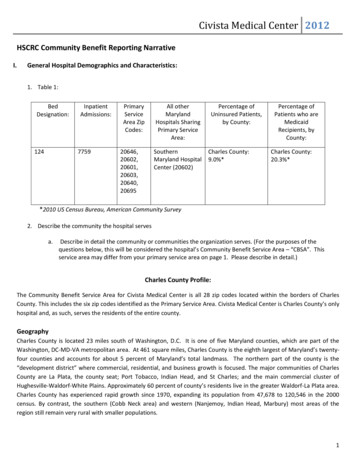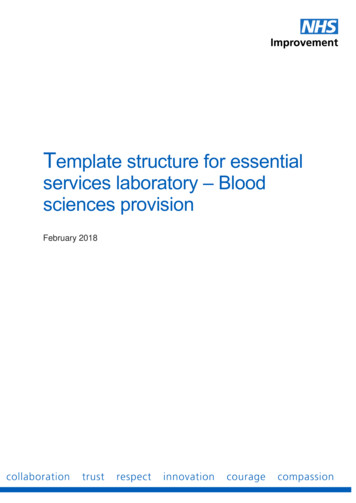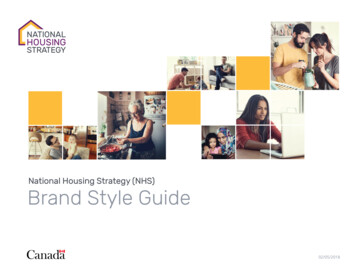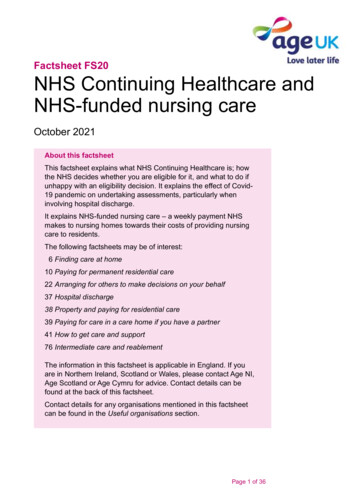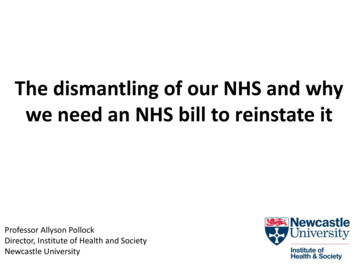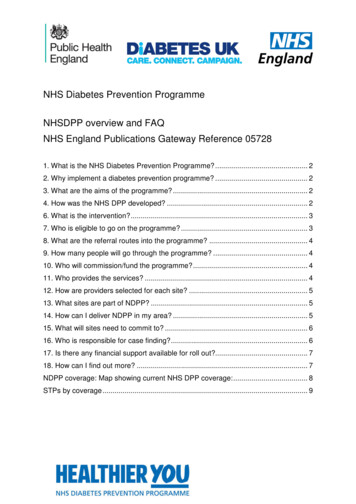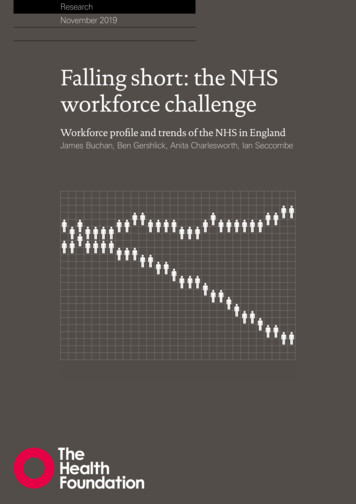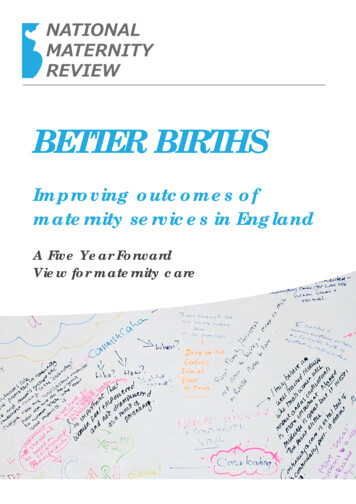
Transcription
NATIONALMATERNITYREVIEWBETTER BIRTHSImproving outcomes ofmaternity services in EnglandA Five Year ForwardView for maternity care
NATIONAL MATERNITY REVIEWA LETTER TO THE WOMEN OF ENGLAND ANDTHEIR FAMILIESThe birth of a child should be a wonderful, life-changing time for a mother andher whole family. It is a time of new beginnings, of fresh hopes and newdreams, of change and opportunity. It is a time when the experiences we havecan shape our lives and those of our babies and families forever. Thesemoments are so precious, and so important. It is the privilege of the NHS andhealthcare professionals to care for women, babies and their families at theseformative times.For me, it has been an honour to lead this national review of maternityservices. Over the last year I have had the opportunity to meet with manywomen and their families. You took the time to share with me your experiencesand reflections on the care you and your loved ones have received – bothgood and bad. You did that willingly and honestly. I have heard manyinspiring stories and wonderful ideas, but also heart-breaking experiences andmoments when the care provided has fallen short. The insight you have givento me into what matters to you, what could be better and where things arealready great, has been tremendously helpful and at times deeply moving. Forthat I thank you.I am particularly grateful to mothers and fathers who shared accounts of thetragedies they experienced – I am in no doubt that our task is to make all careas safe as the best.I have also met many of the healthcare professionals working on the front lineproviding maternity care. Their passion and dedication has been striking.Their opinions, ideas and experience have been invaluable.I was privileged to witness the birth of twins by caesarean section – thebravery of the mother, the calm skill and professionalism of the team and thefirst moments of life of two beautiful babies will stay with me. I heard womenand their partners telling me of life affirming births in their own homes - theplace where they felt most confident, in charge - and how their midwifebecame a close professional friend. Similarly, births in midwifery units withskilled midwives providing care which was compassionate and kind. I met withfathers, who gave me an insight into how they feel and what matters to them so often forgotten but a vital part of the picture. I saw communitiesenthusiastically supporting their local services and healthcare professionals, inrural and urban areas, passionate in their pursuit of high quality services thatmeet their needs.2
NATIONAL MATERNITY REVIEW20 years ago I produced a report as a government minister, ChangingChildbirth, which sought to describe a modern maternity service, as we movedinto a new century. Great strides have been made in transforming maternityservices in those last two decades. Despite the increasing numbers andcomplexity of births, the quality and outcomes of maternity services haveimproved significantly over the last decade. The stillbirth and neonatalmortality rate in England has fallen by over 20% in the last ten years.I have also seen that change has not always happened or has not achievedwhat was initially hoped for. And I have seen that new challenges have arisen.More women have children at an older age. More women have complexhealth needs that may affect their pregnancy, their well-being and that of theirbaby.We heard that many women are not being offered real choice in the servicesthey can access, and are too often being told what to do, rather than beinggiven information to make their own decisions. Hospital services are atcapacity with some running at 100% occupancy too much of the time. Yetsome community-based services are struggling to survive, while some womenare unable to choose the service they want because it sits on the wrong side ofan administrative boundary.We found almost total unanimity from mothers that they want their midwife tobe with them from the start, through pregnancy, birth and then after birth. Timeand again mothers said that they hardly ever saw the same professional twice,they found themselves repeating the same story because their notes had notbeen read. That is unacceptable, inefficient and must change.There is too much variation in quality across maternity services. Healthprofessionals are working under pressure and too often do not work welltogether, especially across the professional divides. They spend far too muchtime collecting data and filling in forms, yet the data we have is often of poorquality, or paper-based when it should be electronic, and in some aspects ofcare, there is no data at all.Things go wrong too often. We spend 560 million each year oncompensating families for negligence during maternity care. And when thingsdo go wrong, the fear of litigation can prevent staff from being open about theirmistakes and learning from them. No family should wait for years as the rightsand wrongs of their tragedy are fought over by lawyers.3
NATIONAL MATERNITY REVIEWAll these factors contribute to the UK having poorer outcomes on somemeasures than our peers in Europe, which is unacceptable. We can and mustdo better. This report seeks to describe how we might do so.There has been much debate as this review has unfolded about twofundamental principles - the importance of women being able to make choicesabout their care, and the safety of the mother and baby being paramount.There has been a good deal of discussion about whether these twocomponents are compatible. Of course it is true that birth is not without risk,but every woman wants – and has a right to – the safest possible birth forherself and her baby. Every woman should also be cared for by serviceswhich fit around and respect her, and her baby’s needs and circumstances.Safe care is personalised care.Women have made it abundantly clear to us that they want to be in control oftheir care, in partnership with their healthcare professionals. With this controlcomes a responsibility which mothers must accept and professionals mustsupport - that personal health and fitness are integral to safe and fulfillingchildbearing.What this review has not sought to do is to inspect and pass judgement onindividual services, nor have we seen our role as to monitor the delivery of allrecommendations from the investigation into the serious failings in maternitycare at Morecambe Bay. Rather, we have sought to learn from these, and tobuild on them in setting out a vision for a modern maternity service thatdelivers safer, more personalised care for all women and every baby, improvesoutcomes and reduces inequalities.It is an ambitious vision and no one action alone will deliver the change we allneed to see. Among those providing maternity care, it will require greaterteamwork, more and better dialogue, and a willingness to break downprofessional boundaries; all in the best interests of women, babies and theirfamilies. It will require an openness and inclusiveness, so that all services canwork together – the independent, voluntary and charitable sectors are a keypart of this and we must support, include and recognise the contribution theymake.It is a vision that reflects what I have heard from you, the women of Englandand your families.It also reflects a consensus that we have sought to build among the healthprofessionals providing maternity care. I believe they have the appetite for thischange. Their commitment, determination and passion to make things betterfor the women, babies and families have been crystal clear. With the right4
NATIONAL MATERNITY REVIEWsupport from national organisations and the inspiration of local leaders, theywill be able to make these changes happen.I urge you to play your part in creating the maternity services you want for yourfamily and your community. Voice your opinions, just as you have during thisreview, and challenge those providing the services to meet your expectations.For me this report is the start of a journey of change. I look forward to the taskahead. Together, we will ensure that our maternity services are amongst thevery best in the world.Baroness Julia Cumberlege,Independent Chair, National Maternity Review5
NATIONAL MATERNITY REVIEWACKNOWLEDGEMENTSI would like to thank my fellow review team members for their time, commitment andenergy in working with me to conduct this review. Your expertise, advice andchallenge has been invaluable, and the vision that we have developed for the futureof maternity services in this country reflects the breadth and depth of theperspectives that you have brought to our important task.6
NATIONAL MATERNITY REVIEWNational Maternity Review Team Members: Professor Sir Cyril Chantler, Vice Chair Alison Baum, Best Beginnings Dr Jocelyn Cornwell, The Point of Care Foundation Dr Catherine Calderwood, Chief Medical Officer for Scotland Rowan Davies, Mumsnet Elizabeth Duff, National Childbirth Trust Sir Sam Everington, GP and Tower Hamlets Clinical Commissioning Group Dr Alan Fenton, Newcastle NHS Foundation Trust Annie Francis, Neighbourhood Midwives Professor Dame Donna Kinnair, Royal College of Nursing Dr Bill Kirkup, Chair of the Morecambe Bay Investigation Sarah Noble, Birmingham Women's NHS Foundation Trust Melany Pickup, Warrington and Halton Hospitals NHS Foundation Trust Dr David Richmond, Royal College of Obstetricians and Gynaecologists James Titcombe OBE, Morecambe Bay parent and Care Quality Commissionadviser on safety, (until September 2015) Janet Scott, Sands, the Stillbirth and Neonatal Death Charity, (afterSeptember 2015) Professor James Walker, University of Leeds Professor Cathy Warwick, Royal College of MidwivesI would also like to acknowledge the unfailing support we have had from the teamfrom NHS England and also from Simon Whale and his staff at Luther Pendragon.7
NATIONAL MATERNITY REVIEWOUR VISIONEvery woman, every pregnancy, every baby and every family is different. Therefore,quality services (by which we mean safe, clinically effective and providing a goodexperience) must be personalised.Our vision for maternity services across England is for them to become safer,more personalised, kinder, professional and more family friendly; where everywoman has access to information to enable her to make decisions about hercare; and where she and her baby can access support that is centred aroundtheir individual needs and circumstances.And for all staff to be supported to deliver care which is women centred,working in high performing teams, in organisations which are well led and incultures which promote innovation, continuous learning, and break downorganisational and professional boundaries.Our report sets out what this vision means for the planning, design and safe deliveryof services; how women, babies and families will be able to get the type of care theywant; and how staff will be supported to deliver such care.A table of recommendations for action, who should take responsibility and whattimescale they should work towards is at Annex A.1. Personalised care, centred on the woman,her baby and her family, based around theirneeds and their decisions, where they havegenuine choice, informed by unbiasedinformation.i.Every woman should develop a personalised care plan, with her midwife andother health professionals, which sets out her decisions about her care,reflects her wider health needs and is kept up to date as her pregnancyprogresses.ii.Unbiased information should be made available to all women to help themmake their decisions and develop their care plan. This should be throughtheir own digital maternity tool, which enables them to access their own healthrecords and information that is appropriate to them, including the latestevidence and what services are available locally.iii.They should be able to choose the provider of their antenatal, intrapartum andpostnatal care and be in control of exercising those choices through their ownNHS Personal Maternity Care Budget.8
NATIONAL MATERNITY REVIEWiv.Women should be able to make decisions about the support they need duringbirth and where they would prefer to give birth, whether this is at home, in amidwifery unit or in an obstetric unit, after full discussion of the benefits andrisks associated with each option.2. Continuity of carer, to ensure safe carebased on a relationship of mutual trust andrespect in line with the woman’s decisions.i.Every woman should have a midwife, who is part of a small team of 4 to 6midwives, based in the community who knows the women and family, and canprovide continuity throughout the pregnancy, birth and postnatally.ii.Each team of midwives should have an identified obstetrician who can get toknow and understand their service and can advise on issues as appropriate.iii.The woman’s midwife should liaise closely with obstetric, neonatal and otherservices ensuring that she gets the care she needs and that it is joined upwith the care she is receiving in the community.3. Safer care, with professionals workingtogether across boundaries to ensure rapidreferral, and access to the right care in the rightplace; leadership for a safety culture within andacross organisations; and investigation,honesty and learning when things go wrong.i.Provider boards should have a board level champion for maternity services.They should routinely monitor information about quality, including safety, andtake necessary action.ii.Boards should promote a culture of learning and continuous improvement tomaximise quality and outcomes from their services.iii.There should be rapid referral protocols in place between professionals andacross organisations to ensure that the woman and her baby can accessmore specialist care when they need it.iv.Teams should routinely collect data on the quality and outcomes of theirservices, measure their own performance and compare against others’ so thatthey can improve.9
NATIONAL MATERNITY REVIEWv.There should be a national standardised investigation process when things gowrong, to get to the bottom of what went wrong and why and how futureservices can be improved as a consequence.vi.There is already an expectation of openness and honesty betweenprofessionals and the family, which should be supported by a system of rapidresolution and redress, encouraging learning and ensuring that familiesquickly receive the help they need.4. Better postnatal and perinatal mental healthcare, to address the historic underfunding andprovision in these two vital areas, which canhave a significant impact on the life chancesand wellbeing of the woman, baby and family.i.There should be significant investment in perinatal mental health services 1 inthe community and in specialist care, as recommended by NHS England’sindependent Mental Health Taskforce.ii.Postnatal care must be resourced appropriately. Women should have accessto their midwife (and where appropriate obstetrician) as they require afterhaving had their baby. Those requiring longer care should have appropriateprovision and follow up in designated clinics.iii.Maternity services should ensure smooth transition between midwife, obstetricand neonatal care, and ongoing care in the community from their GP andhealth visitor.5. Multi-professional working, breaking downbarriers between midwives, obstetricians andother professionals to deliver safe andpersonalised care for women and their babies.1i.Those who work together should train together. Multi-professional learningshould be a core part of all pre-registration training for midwives andobstetricians, so that they understand and respect each other’s skills andperspectives.ii.Multi-professional training should be a standard part of continuousprofessional development, both in routine situations and in emergencies.Perinatal mental health services care for women during pregnancy and in the firstyear after birth10
NATIONAL MATERNITY REVIEWiii.To support sharing of data and information between professionals andorganisations, use of an electronic maternity record should be rolled outnationally. Providers should ensure the woman shares and can input theinformation that is important to her.iv.Data collection should be refocused on the most useful information so as tominimise the burden on women and their professionals. A nationally agreedset of indicators should be developed to help local maternity systems track,benchmark and improve the quality of maternity services.v.Multi-professional peer review of services should be available to support andspread learning. Providers should actively seek out this support to help themimprove, and they should release their staff to be part of these reviews.6. Working across boundaries to provide andcommission maternity services to supportpersonalisation, safety and choice, with accessto specialist care whenever needed.2i.Community hubs should be established, where maternity services, particularlyante- and postnatally, are provided alongside other family-orientated healthand social services provided by statutory and voluntary agencies. Communityhubs should work closely with their obstetric and neonatal unit(s).ii.Providers and commissioners should work together in local maternity systemscovering populations of 500,000 to 1.5 million, with all providers working tocommon agreed standards and protocols.iii.Professionals, providers and commissioners should come together on a largergeographical area through Clinical Networks, 2 coterminous for both maternityand neonatal services. They should share information, best practice andlearning, provide support and advise about the commissioning of specialistservices to support local maternity systems.iv.Commissioners need to take clear responsibility for improving outcomes andreducing health inequalities, by commissioning against clear outcomemeasures, empowering providers to make service improvements andmonitoring progress regularly.formerly Strategic Clinical Networks11
NATIONAL MATERNITY REVIEW7. A payment system that fairly and adequatelycompensates providers for delivering highquality care to all women efficiently, whilesupporting commissioners to commission forpersonalisation, safety and choice.v.The payment system for maternity services should be reformed so that it isfair, incentivises efficiency and pays providers appropriately for the servicesthey provide.vi.In particular, it should take into account:o The different cost structures services have, i.e., a large proportion ofthe costs of obstetric units are fixed because they need to be available24 hours a day, seven days a week regardless of the volume ofservices they provide.o The need to ensure that the money follows the woman and her baby asfar as possible, so as to ensure women’s choices drive the flow ofmoney, whilst supporting organisations to work together.o The need to incentivise the delivery of high quality of care for allwomen, regardless of where they live or their health needs.o The challenges of providing sustainable services in certain remote andrural areas.12
NATIONAL MATERNITY REVIEWCONTENTSA letter to the women of england and their families . 2Acknowledgements . 6Our vision . 8Chapter 1: Introduction . 15Terms of reference and scope . 15Engagement . 16Chapter 2: The case for change. 19Quality assessment . 20Evidence review by the National Perinatal Epidemiology Unit . 29Learning from the Morecambe Bay investigation report . 31Chapter 3: What we heard . 32What we heard from women and their families . 32What we heard from healthcare professionals . 38What we heard from commissioners and provider organisations . 41Chapter 4: Shaping the future. 42A new deal for women, babies and families . 43A new deal for healthcare professionals . 70A new deal between professionals and organisations . 80Chapter 5: Making the Future . 84People . 84Models of care . 87Resources . 90Chapter 6: How much will it cost? . 9413
NATIONAL MATERNITY REVIEWAnnexesAnnex A – Summary table ofrecommendations, owners andproposed timeframesAnnex B – List of visits and eventsAnnex C – Potential scope of NHSPersonal Maternity Care BudgetAnnex D – Potential scope ofinsurance rapid resolution and redressscheme14
NATIONAL MATERNITY REVIEWCHAPTER 1: INTRODUCTION1.1. Pregnancy, the birth and the early weeks of a child’s life are a crucial period forthe future of the family and of the child. 3 For babies, this period has a majorinfluence on their physical, social, emotional and language development. 4, 5 Formothers and the wider family, pregnancy may be the first time they havesustained contact with health services and so presents the ideal opportunity toinfluence their life style and to maximize their life chances. It is therefore vital thatfamilies in England are supported by high quality maternity services which caterfor their needs and support them to begin their new lives together.1.2. Maternity services in England are always in the spot light given their importance tothe people of this country; and especially in recent years due to high profilefailings in care, not least at Morecambe Bay NHS Trust in Cumbria. This reviewwas commissioned in March 2015 by Simon Stevens, Chief Executive of NHSEngland on behalf of the national organisations who authored the Five YearForward View 6 to consider how our maternity services need to change to meet theneeds of the population, and to ensure that learning from the Morecambe BayInvestigation could be embedded throughout the NHS.1.3. Baroness Julia Cumberlege was appointed as independent chair of the reviewand she has been supported by Professor Sir Cyril Chantler as vice-chair and areview team, bringing together the perspectives of midwives, doctors, women’srepresentatives, charities and other experts. The review team was supported by asecretariat from NHS England.Terms of reference and scope1.4. The National Maternity Review was asked in its terms of reference to:i.review the UK and international evidence and make recommendationson safe and efficient models of maternity services, including midwifeled units;3Fair Society Healthy Lives (The Marmot Review), Professor Marmot, 2010.4The Marmot Review, p605Conception to age 2 – the age of opportunity, Wave Trust 2013, p36NHS England, Care Quality Commission, Health Education England, NHSImprovement, National Institute for Health and Care Excellence, and Public HealthEngland15
NATIONAL MATERNITY REVIEWii.iii.iv.ensure that the NHS supports and enables women to make safe andappropriate choices of maternity care for them and their babies;support NHS staff including midwives to provide responsive care;pay particular attention to the challenges of achieving the aboveobjectives in more geographically isolated areas, as highlighted in theMorecambe Bay Investigation report.The NHS Five Year Forward View also said that the review should:v.vi.ensure that tariff-based NHS funding supports the choices womenmake, rather than constraining them; andas a result, make it easier for groups of midwives to set up their ownNHS-funded midwifery services.1.5. The review team met as a group eight times over the course of 2015. At theoutset, the team agreed a scope for the review: encompassing maternity carefrom conception through to six weeks after birth.1.6. The review team also agreed a set of shared goals for the future of maternityservices, which has guided their thinking throughout and in developing this report,as well as a set of workstreams through which they would take forward the review.Figure 1 below describes the shared goals and the workstreams.1.7. This approach enabled the involvement of a far wider group of experts than wouldotherwise have been practical. Their involvement has added depth, breadth andchallenge to the review team’s work. Across all workstreams, the themes ofimproving mental health and public health, and reducing inequalities wereconsidered.1.8.Figure 1: Shared goals and workstreams16
NATIONAL MATERNITY REVIEWEngagement1.9. The review team carried out an extensive programme of engagement with thepublic, users of services, staff, and other stakeholders over the twelve months ofthis review. This activity was to ensure that the review’s findings and conclusionstook into account the opinions, expertise and perspectives of as wide a range ofpeople as possible. It covered all regions, and specifically sought to gather viewsacross rural, urban, and suburban areas.1.10. The programme of engagement included:15 regional drop-in events open to3 focused discussions with groupsthe public, women and theirfamilies, commissioners, charities,clinicians and other stakeholders togive their views on currentmaternity services – highlighted inblue on figure 2of women and families fromseldom heard groups who usematernity services38 visits to different services to talkto women, their clinicians and thosewho commission services on theirbehalf – highlighted in orange onfigure 2An online consultation, which ranfrom 9 September to 15 Novemberwomen and families who haveexperienced loss or complicationsaffecting the health of the motheror baby, as well a survey for thosewho were unable to attend theevents, which received 1200responses46 Individual meetings with keyand received 5192 responsesstakeholders and experts togather their insight and expertiseTwo national BirthTank events with3 international visits to Sweden,300 key stakeholders to listen toand test emerging findings156 submissions to the maternityreview email inbox174 dedicated listening events forDenmark and the Netherlands tolearn about countries with differentcultures of maternity care andidentify good models of practicewhich can be developed for use inEngland.
NATIONAL MATERNITY REVIEW1.11. A full list of engagement events and visits is presented at Annex B. A largenumber of people and organisations have taken time to engage with the reviewand have influenced this report. The review team would like to thank everyonewho took the trouble to speak or write to them. Their insight has informed thisreview, and is referenced throughout.Figure 2: map of engagement events and visits18
NATIONAL MATERNITY REVIEWCHAPTER 2: THE CASE FOR CHANGE2.1. The total number of births in England has fluctuated since declining to a low in1977. In 2014 there were 664,543 births in England, compared to 566,735 in2001. 7 By 2020 the number of births will have increased by 3% to 691,038,although by 2030 it will have begun to fall and is projected to be 686,142.2.2. Women are giving birth later: there has been a steady increase in the averageage of first time mothers from 27.2 years in 1982 to 30.2 years in 2014. Theproportion of women who have conditions such as diabetes in pregnancy hasincreased. In line with these trends, a higher proportion of births involve morecomplex care, which requires risks to be managed and more interventions. 82.3. There are 136 NHS trusts 9 in England providing maternity services in a range ofsettings, plus 15 mother and baby units provided by mental health trusts. Thereare four broad types of setting for care in labour and birth: at home, freestandingmidwifery units (FMU), alongside midwifery units (AMU) and hospital obstetricunits (OU). In 2012, 87% of births took place in NHS obstetric units. Although96% of trusts offered home births, 2.4% of births were at home (see figure 3). 102.4. Data from the Royal College of Obstetricians and Gynaecologists (RCOG) showsthat there are approximately 1,970 consultants and 1,630 trainees working in theObstetrics and Gynaecology specialty in England. Data from the Health andSocial Care Information Centre (HSCIC) shows that in 2014 there were a total of21,517 full time equivalent midwives working in maternity services based on ahead count of 26,139. 117Office for National Statistics, Birth Characteristics in England and Wales 20148Comptroller and Auditor General, Maternity Services in England, Session 2013-14HC 794, National Audit Office, November 20139Based on 2015 Friends and Family Test submissions10Comptroller and Auditor General, Maternity Services in England, Session 2013-14HC 794, National Audit Office, November 2013, p.2911HSCIC Workforce Annual Census19
NATIONAL MATERNITY REVIEWFigure 3: Number of births by unit type, 2012 (also referenced in the NHS Five YearForward View). Women’s preferences from survey of 55
Childbirth, which sought to describe a modern maternity service, as we moved into a new century. Great strides have been made in transforming maternity services in those last two decades. Despite the increasing numbers and complexity of births, the quality and outcomes of maternity services have improved significantly over the last decade.
